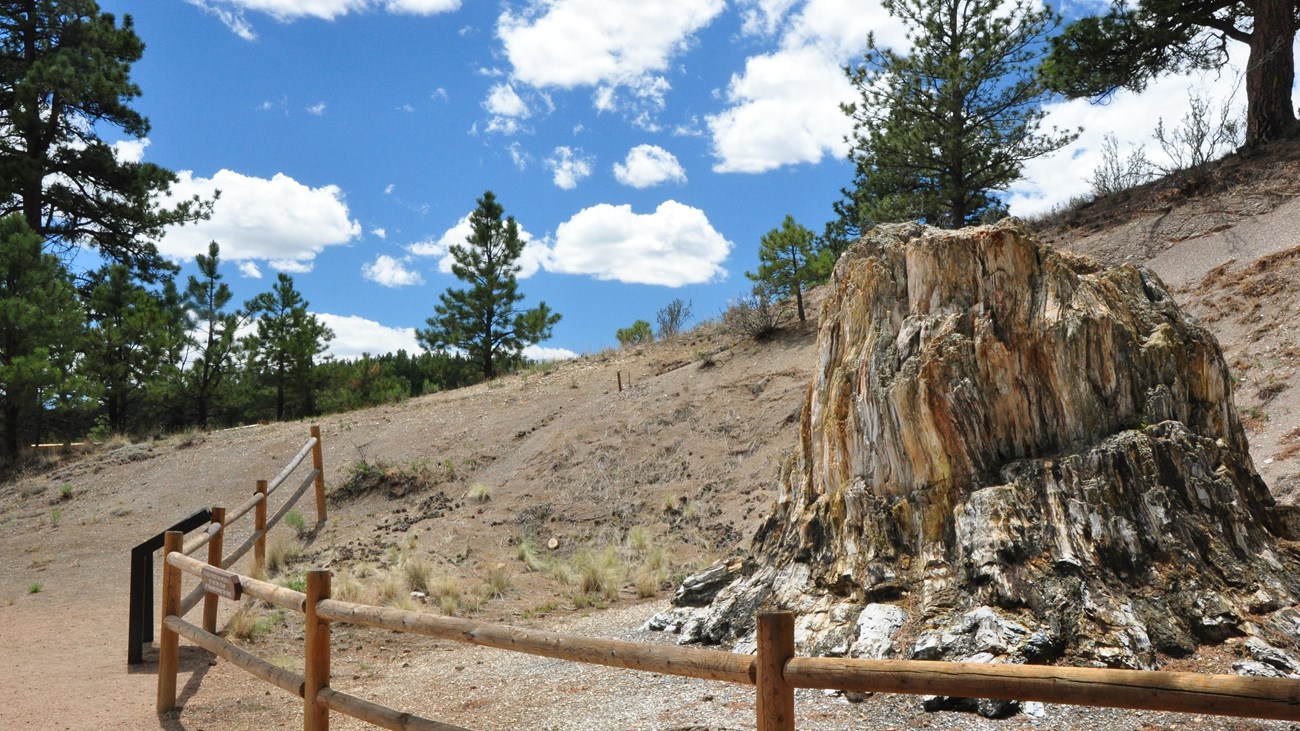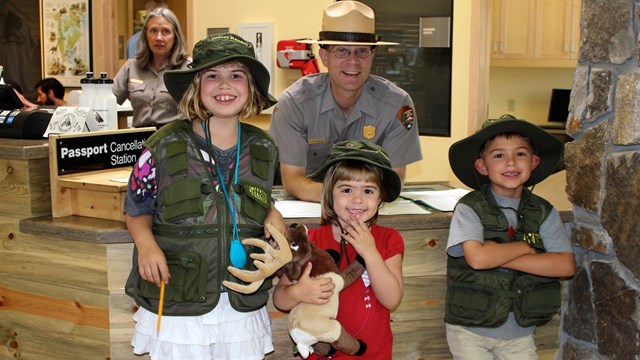The Florissant valley appears timeless.
Life suited to a cool, temmperate climate flourishes here
But the world around us is constantly changing
Mountains rise and erode away
Life thrives and changes in a blink.
Our sense of time and the environment around us is grounded in the present
But our planet, its climate, and its communities of life have been changing for millions of years
Sometimes despite innumerable odds, a shadow of the past survives.
providing clues to ancient life that once existed in this very place.
The geology, fossils, and human stories of Florissant Fossil Beds National Monument are part of a common geologic heritage The layers of rock beneath this valley contain one of the richest fossil deposits in the world.
They hold clues of unexpected environments and life that existed here during a time called the late Eocene. dinosaurs were extinct,and it was now the age of mammals.
Around 37 million years ago
a distance explosion from a collapsing volcanic crater known as a caldera
sent an enormous flow of superheated ash and gas racing across the landscape like a volcanic hurricane
incinerating everything in its path
Slowly, life regained a foothold by 34 to 35 million years ago as new, powerful volcanoes loomed over the Florissant valley.
Periodic eruptions blanketed the valley with ash and debris.
Rainfall saturated the loose debris on the slopes of the volcano creating a massive fast moving mudflow called a lahar.
It was miles long and roughly fifteen feet tall when it reached the Florissant valley.
The slurry of mud and volcanic ash surrounded the bases of the towering redwoods.
As the redwoods died, their tops decayed away.
Groundwater, rich in dissolved silica from volcanic ash, gradually seeped into the wood, depositing minerals and petrifying it over time.
Volcanic eruptions continued over thousands of years
Another flowing lahar blocked a stream, creating the ancient Lake Florissant.
After several millennia this lake and the landscape surrounding it nourished an abundance of life.
Volcanic ash and clay settled on the lakebed creating layers of various thickness over time.
Single-celled algae called diatoms thrived in the mineral-rich water then died periodically.
The layers compressed and formed a thinly layered sedimentary rock called paper shale.
Leaves, seeds, insects, fish, and even birds settled to the bottom of the lake where they were buried by new layers of volcanic ash, clay, and diatoms.
Millions of years later, the shale holds fragile fossils, physical touchstones to ancient life, inspiring the mind with connections to this land and its past.
Shadows of ancient human history can also be found here, part of the shared geologic heritage of Florissant.
The Ute, Jicarilla Apache, and other tribes consider the area part of their ancestral lands.
Tribal members still have a strong connection to this area.
Paleontologists have been exploring the area since the 1870s
describing more than 1,800 species
making Florissant one of the richest fossil sites in the world.
Samuel Scudder conducted an excavation in the Florissant area in 1877, indentifying roughly 600 species.
Attracted by the Homestead Act of 1862, new settlers began estabishing ranches and farms in Florissant.
Charlotte Hill collected hundreds of important fossil specimens that she provided to scientists while homesteading and raising six children.
In gratitude, the fossil rose, Rosa Hilliae, was named after her.
Charlotte Hill collected one of the most remarkable fossil butterflies ever found, Prodryas persephone commonly known as a brush-footed butterfly.
Other brush-footed butterflies live in the Florissant ecosystem today.
Hundreds of new species of fossil plants, insects, spiders, and vertebrates were described as a result of Hill's work with scientists.
The shear number of fossils on the site made an impression on paleontologists like Theo Cockerell, who arrived in 1906.
COCKERELL: There has accumulated and almost embarassing amount of material, and many remarkable things have been discovered.
NARRATOR: Florissant fossils were sent to museums around the world, and the site became famous.
Tourists arrived eager to see the giant petrified stumps and to collect fossils as souveniers.
Dynamite was used to better expose the petrified stumps.
An attempt was even made to saw the big stump into pieces to ship to the 1893 World's Fair in Chicago.
Broken saw blades from the effort still remain.
Colorado Midland Railway allowed passengers to disembark at Florissant and collect fossils.
By the 1920s, tourists were beckoned by commercial sites and a dude ranch with a fireplace made from petrified wood.
SINGER: Now at one time, there were big petrified stumps and logs lying on the ground all around the countryside
but they have mostly been sold or stolen away.
NARRATOR:Paleontologist Harry MacGinitie began studying Florissant's fossils in the 1930s.
He saw the Florissant fossil area as key to understanding the story of life's past.
But years of uncontrolled collecting, had led to the increasing disappearance of the fossils.
Scientific and local communities began to call for conservation of the fossil beds.
In 1969, land containing fossils at Florissant was targeted for housing development.
The fossils and their clues to ancient life could be lost forever.
Scientists like Estella Leopold and other citizens formed a group called the Defenders of Florissant.
Paleobotanists MacGinitie joined Leopold and others to testify before Congress
and then brought senators to see Florissant first hand
MacGinitie: The land is not of particularly great value for housing or agriculture, but as a page of Earth's history it is priceless.
LEOPOLD: How can man evaluate his planetary environment and visulaize his historic place in it if he does not keep and cherish a few touchstones from the past?
NARRATOR: in a landmark environmental case, a legal team went to court to stop the imminent destruction of Florissant's fossils and their record of ancient life.
YANNACONE: To sacrifice this 34 million year old record for 30 year mortgages and basements is like wrapping fish with the Dead Sea Scrolls.
Narrator: On August 20, national monument status was granted to Florissant Fossil Beds, safeguarding it's geologic heritage for the world.
Some of the largest petrified stumps on the planet that onced faced bulldozing and dynmaite are now protected and monitored for any damage from the environment or weather.
It is estimated that some of these trees were over 230 feet tall and over 500 to 750 years old.
Florissant has the only known petrified trio, interconnected trunks growing as one plant.
The national monument paleontology staff and university partners conduct ongoing research
and work to stabilize and conserve fragile shale fossils and petrified stumps
keeping it possible for future scientists to study the fossils with new methods
so that they can reveal even more knowledge of the past.
Countless fossils are only visible under a microscope.
Millions of pollen grains, diatoms,and microscopic invertebrates are preserved at Florissant.
Microfossils are critical to understanding habitat, water quality, and climate here 34 million years ago.
By compaing Florissant's fossils to modern plants scientists can determine temperature and precipitation from the ecosystems of the ancient past.
Right after the end of the warm Eocene, there was a huge drop in global temperature.
The Florissant climate changed abruptly to a cooler temperature climate.
Plants native to the warmer climate either adapted, became extinct, or dispersed to warmer regions.
Fossils reveal to scientists how plants and animals responded to climate change in the past.
Modern relatives of the golden rain tree are native only to China, Taiwan, and Fiji
yet they once existed at Florissant milions of years ago.
The two most common plant fossils are extinct members of the elm and beech families.
Fossils of more than 30 species of vertebrates have been found.
The largest vetebrates were brontotheres, giants weighing two tons and standing eight feet tall.
Fish skeletons and mammal teeth are the most abundant.
Rare bird fossils have visible feathers captured in stone.
Florissant is especially noted for its delicate insect and spider fossils.
Fossil plants show evidence of damage from insects similar to today.
Delicate fossil butterflies and moths are very rare. Florissant has more species of these ,perhaps than any other fossil site in the world.
This extremely rare tsetse fly is evidence of a different climate that once existed at Florissant.
The tse tse fly now live only in tropical Africa
For ancient life, temperature changes occurred over tens of thousands of years
Some life became extinct some adapted to the changing climate and environment.
And some dispersed to other places where the climate was more favorable.
Climate change is happening today at a much more rapid rate
Florissant fossils allow us to look to the past to better understand the present.
and to guide our stewardship of life in the future.





